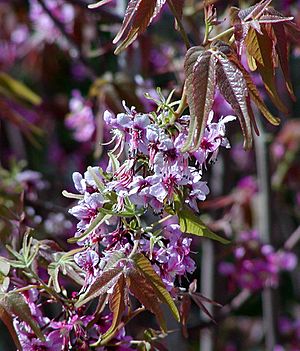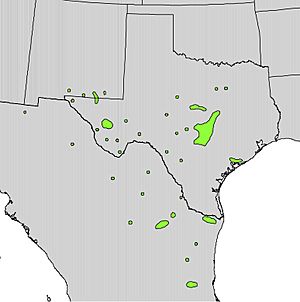Mexican buckeye facts for kids
Quick facts for kids Mexican buckeye |
|
|---|---|
 |
|
| Mexican Buckeye flowers | |
| Scientific classification | |
| Genus: |
Ungnadia
|
| Species: |
speciosa
|
 |
|
| Natural range | |
The Mexican buckeye, scientifically named Ungnadia speciosa, is a special kind of flowering plant. It's the only species in its group, which is called the Ungnadia genus. This plant grows naturally in northern Mexico and parts of the southern United States, like Texas and southern New Mexico.
The name Ungnadia honors Baron David von Ungnad. He was an ambassador from Austria. In 1576, he brought the horse chestnut tree to Vienna, introducing it to Europe.
The Mexican buckeye is different from other buckeye trees in the Aesculus genus. However, its seeds look similar to their nuts. It's also related to the soapberry plant, which is in the Sapindus genus.
It's important to know that Mexican buckeye seeds are not safe to eat, even though they might look sweet. People sometimes use the seeds like marbles for games. The leaves are also toxic, so animals usually don't eat them. But bees love the flowers! They collect nectar from them to make honey.
Contents
What the Mexican Buckeye Looks Like
The Mexican buckeye is a deciduous plant. This means it loses its leaves every year, usually in the fall. It grows as a shrub or a small tree, usually less than 25 feet (about 7.6 meters) tall. Often, it has several trunks instead of just one.
Leaves and Flowers
The leaves of the Mexican buckeye are quite long, usually between 5 and 12 inches (12 to 30 cm). They grow in an alternating pattern along the stem. Each leaf is made up of 5 to 9 smaller leaflets. These leaflets are long and narrow, about 3 to 5 inches (7.6 to 12.7 cm) in length. They have pointed tips and slightly jagged edges.
The flowers are usually pink and grow in clusters. They appear in early spring, often before the leaves fully open. These pretty flowers are what attract bees to the plant.
Where it Grows
The Mexican buckeye prefers sunny spots and can grow in different types of soil. It's often found in rocky areas, canyons, and along stream banks. It's quite tough and can handle dry conditions once it's grown.
Natural Habitat
In Mexico, you can find this plant in states like Chihuahua, Coahuila, Nuevo León, and Tamaulipas. In the United States, it's common in Texas and parts of New Mexico. It's a native plant, meaning it has grown in these areas for a very long time.
See also
 In Spanish: Ungnadia para niños
In Spanish: Ungnadia para niños


